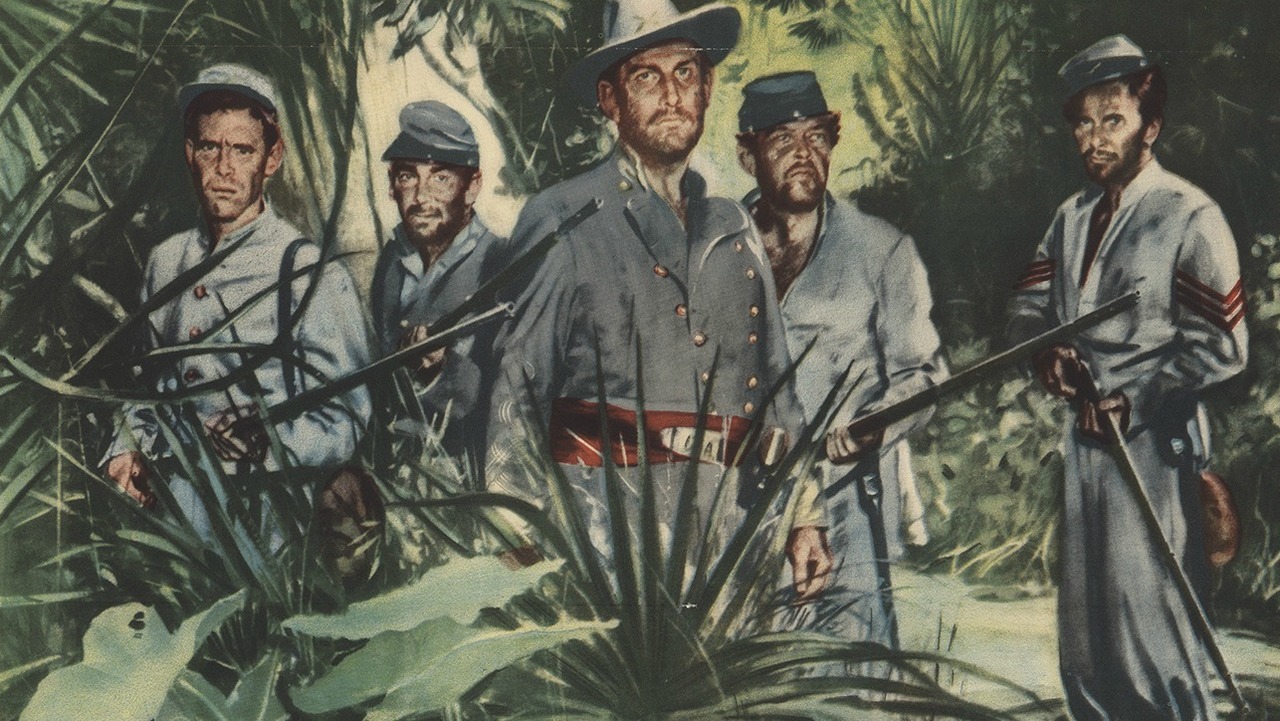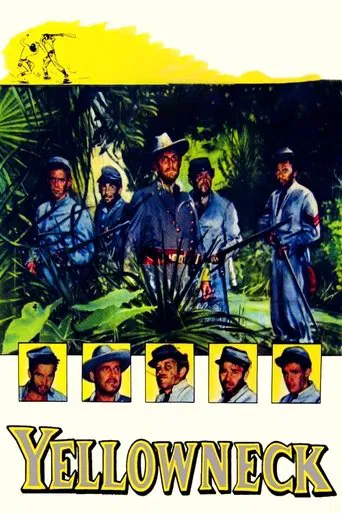

Never waste 90 minutes of your time on this terrible take on Civil War. Some old films were never good, and this is one of them. The story of 5 Cofederate deserters (Yellownecks, as they were called) could have been OK, but here it was not. Slow, poorly shot film is only good for the Florida Everglade views, animals, snakes, gators, jungles, bogs and rivers. The 5 actors are intermittently forgettable ad pathetic. They encounter almost every ordeal on the way and it is obvious which next they will come soon into. Nay, sirs, this was not good in the 50's, it is boring and dull now. What is especially bad, is that we feel no pity for them. The film is cold and bland, and the performance is rather mediocre. Just going slowly and very predictably. You know the end at the very beginning and you know it will be not cool to watch it with any interest. Utterly forgettable and banal
... View MoreFive Confederate deserters plunge into the perilous Everglades swamp in a desperate bid for freedom in freshman writer & director R. John Hugh's "Yellowneck," a gritty but scenic yarn about survival in the wilderness during the American Civil War in 1863. Essentially, nobody wins our sympathy here because they are all deserters on the run. Moreover, the characters are at best sketchy, and the largely unknown cast imparts little in the way of charisma. In other words, you won't be rooting for these poor slobs. Had Hugh written his film about men trying to escape from a prison camp, "Yellowneck" might have been more interesting. As it remains, this costume opus is a dreary, depressing movie that you have to struggle to survive yourself. The only reason that I suffered through this 83-minute epic was that it came as the second feature on the bargain basement Alpha Video DVD that toplined the John Agar/Mike Connors western "Flesh and the Spur." Mind you, "Flesh and the Spur" was no triumph of cinematic artistry, but it was far more rewarding than "Yellowneck." This low-budget Republic potboiler boasts the virtues of not only being lensed on-location in the Everglades but also shot in color. Hugh doesn't rely on either studio sets or back projection. Okay, the Seminole Indian camp looks like it was erected for the purposes of the film."Yellowneck" opens with a painting of dead soldiers either draped on a cannon or lying at its wheels. Heavy-handed narration ensues: "This is the story of five men who were the product of a long, bloody war. Five men who turned their backs on the Confederate cause to run. History has a name for the man who runs in the face of battle: deserter. But to the rank and file of the men in the Confederate lines, he was called Yellowneck. The narrative unfolds with the Colonel (Stephen Courtleigh of "North to Alaska") entering the make-shift camp of four Confederate deserters. Sergeant Todd (Lin McCarthy of "The D.I.") is in nominal charge of Plunkett (Berry Kroeger of "Blood Alley"), the Cockney (Harold Gordon of "East of Eden") and the Kid from Georgia (Bill Mason) who knows how to hunt raccoons for meat. The Colonel presents his credentials for safe passage to a British ship and transport to Cuba. He is searching for a Native American guide to escort him through the 'green hell' of the Everglades. Not only are his hopes dashed almost immediately as his guide shows up just long enough to die at their feet, but Sergeant Todd recognizes the bearded, sword-toting officer as a deserter just like they are. When Todd tries to rally his men around the Colonel, the officer admits that he wants nothing to do with being a commander. He has a moment before he dies near the end when he relives the nightmare that was the Battle of Murfreesboro, fought between December 31, 1862, and January 2, 1863, in Tennessee, as part of the Stones River Campaign. The Colonel remembers only the failed charge that he led and the men who died in vain. The significance of the battle was that it proved inconclusive and the Union derived more from it than the Confederacy.Basically, "Yellowneck" is a movie about losers. Again, if Hugh had made the men more heroic or at least redeemed them, then this might have been more appetizing to watch. The Colonel is the first to die. Initially, he takes an arrow in the back when they storm a Seminole Indian camp. The second to die is the mercenary Englishman named Cockney who spends his time lusting after Plunkett's gold and smutty French postcards. Cockney dies when he is paralyzed by fear at the sight of a nest of rattlesnakes. To his credit, Hugh foreshadows Cockney's demise early when Plunkett taunts him with a harmless snake. The three remaining Confederates successfully cross an alligator infested river on a log, but Plunkett goes mad when he realizes that he has lost his gold. He tries to go back for it and ends up being gator bait. The most sympathetic of the quintet is Sergeant Todd who dies an ignominious death in a quicksand pit. Predictably, the one who survives is the simple-minded Kid who reaches the shore. Indeed, his future doesn't look much better. Although Hugh wrote the dialogue and Nat Linden penned the screenplay, neither uses the story as a soapbox for either anti-war sentiments or anti-Confederate commentary. Finally, aside from the French post cards which are never shown, "Yellowneck" features no women.
... View MoreI have not seen this one since the 1960's but we would re-enact it when we played civil war. If I remember correctly these Confederates had been running a prison camp (3/07 I remembered wrong! It was the Seminole Village scene in the middle of the movie) and now (upon the near defeat of the south) were escaping to Cuba. (I guess as deserters according to the other comments.) In order to do so they have to pass thru the Everglade swamps where (like Heart of Darkness) things become more dangerous and evil as they go. Indians, alligators, snakes all finish off (except for one to tell the tale of course) the members of the party one by one. The snake pit was nice cause I did not like the guy who died in it.The scene I most remember is the quicksand scene where the Sergeant sinks and dies leaving the kid alone to finish the trek to Cuba. The rest of the troop dies in different ways. The film finishes with the kid, the one good guy in the film, walking out of the Jungle onto a beach where he looks across the sea in the direction of his destination, Cuba.This was an amusement park of horror. It is too bad that Arnold and Sly are too old now as I think it would make a good film to remake. Time is passing however and the casting of this thing would be a challenge. The film can be downloaded from eztakes.com but it is available on DVD if you search for it.It is really very good and the guy playing the officer has a great death scene!)
... View MoreFirst movie my father co-produced with R. John Hugh. Used color as a first since many movies were in b/w in 50s. Although I was too small to remember this movie being made, I played with rolls of cutting room floor scraps for years.This was Laurence Rosenthal's first movie music score. He was a student at Rollins College in Winter Park, FL. He went on to score more movies and several TV shows in the 90s. Interestingly, a promotion still picture my father had of him was in the newspaper 40 years after it was originally taken. Guess no one ages in the movie business.The scenes that take place during a storm were actually shot during a hurricane that visited Florida during the shooting schedule. Snakes used in the scenes came from a local tourist trap called Alligator Farm. Many of the exterior scenes were made in Altamonte Springs area.The quicksand scene was actually a pit that was dug about chest deep and filled with leaves, etc. The actor got in and faked the sinking part. The hand going down was actually a closeup of him just pulling down his arm (trick photography 50s style). The Florida panther that jumps out of the tree was a fake that was pushed from behind by a guy with a pole. Looks real though.Yellowneck was R. John Hugh's first stab at writing, directing, producing, et AL, a movie in Florida. The world premiere was held at the former Astor Theater in Orlando. I have the still pictures of the premiere. Lin McCarthy was on hand for the opening night. He later went on to do television.
... View More